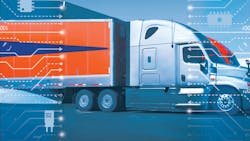Trailer connectivity increasingly critical: CV Tech panel
Once upon a time, truck and trailer equipment suppliers manufactured only hard parts. What was once considered off the shelf, more mechanical components and information have since shifted to today’s connected, data-driven ecosystem.
Commercial vehicle suppliers today are putting even more emphasis on connecting tractor-trailer data to create holistic units for fleets. They are also focused on the importance of integrating with existing fleet telematics software as well as offering turnkey solutions that might be a carrier’s first step toward a connected fleet environment.
Now available: 2022 Commercial Electric Vehicle Adoption Report
“When we look at the tractor-trailer relationship, the trailer has information and data both when it’s connected to the truck, as well as value when it’s not connected,” Mark Ehrlich, senior director of business development at Wabash, pointed out during Endeavor Business Media’s recent virtual CV Tech Conference, which was led by EBM's Commercial Vehicle Group editors.
When fleets are making decisions about spec’ing trailers and equipment given today’s abundance of technology options, David McKean, business development lead at Clarience Technologies, advised looking at a telematics system that is completely scalable. Road Ready, for example, is Clarience’s advanced telematics portion of the company that provides visibility into the health and location of fleet assets.
During the panel, Robert Brazeau, director of strategic initiatives for Meritor’s front-drive and trailer business, pointed out that the industry is focused on developing sensor technology and algorithms to thoroughly mine the data coming off fleets’ assets.
“Fleets need actionable data, and they need it boiled down to what’s really important,” Brazeau explained.
During the CV Tech panel discussion, Paul Washicko, VP and general manager of ConMet’s digital business unit, said the telematics industry is undergoing a natural evolution from its remote diagnostic origins some 20 years ago.
ConMet, a global manufacturer of wheel hubs, also launched its eMobility business in 2020 to help enable the development of electric vehicles.
“Over the years, we have developed and understand well what the thermal vibrations are for hubs that are beginning to fail and for bearings that are beginning to fail,” Washicko said. “This provides better utilization of equipment and drivers, and from preventing thermal events.”
ConMet is working on a second-generation prognostics algorithm that can detect a bearing problem even when it’s too early for a technician to detect something is wrong.
“We have all these different components that we put on the board, but the firmware and the expertise that we drive into that firmware is what allows us to see this so early,” Washicko explained.
“I am reluctant to say that because everyone has been promising it for a long time,” he added. “But we had a recent event where we saw similar signatures on a bearing failure, which was a flat-out bearing failure. When it was brought in for a PM, the technicians let it back out and we said, ‘You’ve got to bring it back in.’ When they brought it back in, they ended up averting a catastrophic event.”
When it comes to scheduling maintenance, Meritor’s Brazeau added that fleets will have to change their models slightly to make use of the data as it comes in. Part of that will mean a better understanding of how they can get the full life from their components.
“It also gives them the peace of mind,” Brazeau noted. “Each fleet has a different answer depending on their operation and where their costs lie. With the data we have now, we can help fleets improve their uptime, help with their operating costs, and when it comes to wheel-end componentry, we can apply data that will help make that vehicle safer on the road.”
As commercial electric vehicles become more widespread, Clarience’s McKean believes telematics and vehicle connectivity will be that much more important—particularly when it comes to range management.
“It’s critical to know the weight in a trailer and what point in time so you can recalculate range, so the driver can get from Point A to Point B successfully or know if they need to get to a charging station,” McKean pointed out. “At the same time, connectivity is important on those electric CVs. If you can monitor tire inflation, for instance, and minimize rolling resistance, you will get more miles to the charge.”
